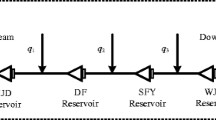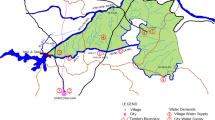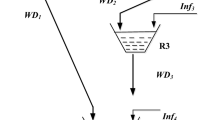Abstract
Water scarcity is one of the most serious problems in many parts of the world that affects negatively on the environment, society, and economy. In order to mitigate the negative effects of this issue, optimal water resource management is pivotal. In current paper, imperialist competitive algorithm (ICA) and cuckoo optimization algorithm (COA) which they are two new evolutionary methods, were used in optimal operation of reservoir. Firstly, these algorithms were used in solving several benchmark problems. Afterwards, optimal operation policy of Karun4 reservoir was extracted. Karun4 is located in Chaharmahal Va Bakhtiari province in western of Iran. Finally, the results which obtained from these methods were compared with genetic algorithm (GA) and nonlinear programing (NLP). In benchmark problems, COA converges to optimal point appropriately well and shows best performance. In these problems, ICA represent suitable ability to achieve global optimum. Both COA and ICA algorithms showed high performance in extraction of optimal operation policies from Karun4, which was conducted over a period of 360 months, with the aim of maximizing productivity. COA indicated the best performance with average value of 5.454 for objective function, and ICA with 6.461 value was at the second rank. In addition, GA objective function value was 6.869. Also NLP solver of Lingo11 was used in order to optimal operation of Karun4 reservoir for evaluating the ability of these algorithms to achieve global solution. Objective function value which was gained by NLP method was 5.243. The results reflect the strength of COA in approaching global optimum.












Similar content being viewed by others
References
Ackley DH (1987) A connectionist machine for genetic hill climbing
Afshar A, Masoumi F, Solis SS (2015) Reliability based optimum reservoir design by hybrid ACO-LP algorithm. Water Resour Manag 29(6):2045–2058. doi:10.1007/s11269-015-0927-9
Ahmadi M, Haddad OB, Loáiciga HA (2015) Adaptive reservoir operation rules under climatic change. Water Resour Manag 29(4):1247–1266. doi:10.1007/s11269-014-0871-0
Ahmed JA, Sarma AK (2005) Genetic algorithm for optimal operating policy of a multipurpose reservoir. Water Resour Manag 19(2):145–161. doi:10.1007/s11269-005-2704-7
Alaya BA, Souissi A, Tarhouni J, Ncib K (2003) Optimization of Nebhana reservoir water allocation by stochastic dynamic programming. Water Resour Manag 17(4):259–272. doi:10.1023/A:1024721507339
Atashpaz-Gargari E, Lucas C (2007). Imperialist competitive algorithm: an algorithm for optimization inspired by imperialistic competition. In Evolutionary Computation, 2007. CEC 2007. IEEE Congress on (4661–4667). IEEE. September, 2007, Singapore. doi: 10.1109/CEC.2007.4425083
Bai T, Wu L, Chang JX, Huang Q (2015) Multi-objective optimal operation model of cascade reservoirs and its application on water and sediment regulation. Water Resour Manag 1–20. doi:10.1007/s11269-015-0968-0
Blanchini F, Ukovich W (1993) Linear programming approach to the control of discrete-time periodic systems with uncertain inputs. J Optimiz Theory App 78(3):523–539. doi:10.1007/BF00939880
Bozorg Haddad O, Afshar A, Mariño MA (2011) Multireservoir optimisation in discrete and continuous domains. Proc ICE Water Manag 164(2):57–72. doi:10.1680/wama.900077
Chau KW, Albermani F (2003) Knowledge-based system on optimum design of liquid retaining structures with genetic algorithms. J Struct Eng 129(10):1312–1321. doi:10.1061/(ASCE)0733-9445(2003)129:10(1312)
Cheng CT, Wang WC, Xu DM, Chau KW (2008) Optimizing hydropower reservoir operation using hybrid genetic algorithm and chaos. Water Resour Manag 22(7):895–909. doi:10.1007/s11269-007-9200-1
Chiang PK, Willems P (2015) Combine evolutionary optimization with model predictive control in real-time flood control of a river system. Water Resour Manag 1–16. doi:10.1007/s11269-015-0955-5
Chow VT, Cortes-Rivera G (1974) Application of DDDP in water resources planning. Department of civil engineering, University of illinois at urbana-champaign, IL, USA. Research report
Esat V, Hall MJ (1994) Water resources system optimization using genetic algorithms.In: Proceedings of first international conference on hydroinformatics, Balkema, Rotterdam, The Netherlands, 225–231
Foufoula-Georgiou E, Kitanidis PK (1988) Gradient dynamic programming for stochastic optimal control of multidimensional water resources systems. Water Resour Res 24(8):1345–1359. doi:10.1029/WR024i008p01345
Galelli S, Soncini-Sessa R (2010) Combining metamodelling and stochastic dynamic programming for the design of reservoir release policies. Environ Model Softw 25(2):209–222. doi:10.1016/j.envsoft.2009.08.001
Goldberg DE, Kuo CH (1987) Genetic algorithms in pipeline optimization. J Comput Civ Eng 1(2):128–141. doi:10.1061/(ASCE)0887-3801(1987)1:2(128)
Jian-Xia C, Qiang H, Yi-Min W (2005) Genetic algorithms for optimal reservoir dispatching. Water Resour Manag 19(4):321–331. doi:10.1007/s11269-005-3018-5
Labadie JW (2004) Optimal operation of multireservoir systems: state-of-the-art review. J Water Resour Plann Manag 130(2):93–111. doi:10.1061/(ASCE)0733-9496(2004)130:2(93)
Labadie JW, Zheng F, Wan Y (2012) Optimal integrated operation of reservoir-assisted stormwater treatment areas for estuarine habitat restoration. Environ Model Softw 38:271–282. doi:10.1016/j.envsoft.2012.07.005
Mellal MA, Adjerid S, Williams EJ, Benazzouz D (2012) Optimal replacement policy for obsolete components using cuckoo optimization algorithm based-approach: dependability context. J Sci Ind Res 71:715–721
Mokhtari Fard M, Noroozian R, Molaei S (2012) Determining the optimal placement and capacity of DG in intelligent distribution networks under uncertainty demands by COA. In: Smart Grids (ICSG), 2012 2nd Iranian Conference on 1–8. IEEE, May, 2012, Iran
Momtahen S, Dariane AB (2007) Direct search approaches using genetic algorithms for optimization of water reservoir operating policies. J Water Resour Plann Manag 133(3):202–209. doi:10.1061/(ASCE)0733-9496(2007)133:3(202)
Mousavi Rad SJ, Akhlaghian Tab F, Mollazade K (2012) Application of imperialist competitive algorithm for feature selection: a case study on bulk rice classification. Int J Comput Appl T 40(16):41–48. doi:10.5120/5068-7485
Mousavi SJ, Ponnambalam K, Karray F (2005) Reservoir operation using a dynamic programming fuzzy rule–based approach. Water Resour Manag 19(5):655–672. doi:10.1007/s11269-005-3275-3
Murray DM, Yakowitz SJ (1979) Constrained differential dynamic programming and its application to multireservoir control. Water Resour Res 15(5):1017–1027. doi:10.1029/WR015i005p01017
Nagesh Kumar D, Raju KS, Ashok B (2006) Optimal reservoir operation for irrigation of multiple crops using genetic algorithms. J Irrig Drain Eng 132(2):123–129. doi:10.1061/(ASCE)0733-9437(2006)132:2(123)
Oliveira R, Loucks DP (1997) Operating rules for multireservoir systems. Water Resour Res 33(4):839–852. doi:10.1029/96WR03745
Oskuyee MA (2012) Evaluation of optimization methods ant colony and imperialist competitive algorithm in face emotion recognition. Int J Adv Res Comput Sci 3(1):206–209
Ponnambalam K, Vannelli A, Unny TE (1989) An application of Karmarkar's interior-point linear programming algorithm for multi-reservoir operations optimization. Stoch Hydrol Hydraul 3(1):17–29. doi:10.1007/BF01543425
Porse EC, Sandoval-Solis S, Lane BA (2015) Integrating environmental flows into multi-objective reservoir management for a transboundary. Rio Grande/Bravo. Water Resour Manag, Water-Scarce River Basin, pp 1–14. doi:10.1007/s11269-015-0952-8
Rajabioun R (2011) Cuckoo optimization algorithm. Appl Soft Comput 11(8):5508–5518. doi:10.1016/j.asoc.2011.05.008
Rani D, Moreira MM (2010) Simulation–optimization modeling: a survey and potential application in reservoir systems operation. Water Resour Manag 24(6):1107–1138. doi:10.1007/s11269-009-9488-0
Reddy MJ, Nagesh Kumar D (2006) Optimal reservoir operation using multi-objective evolutionary algorithm. Water Resour Manag 20(6):861–878. doi:10.1007/s11269-005-9011-1
Rosenbrock HH (1960) An automatic method for finding the greatest or least value of a function. Comp J 3(3):175–184. doi:10.1093/comjnl/3.3.175
Sharif M, Wardlaw R (2000) Multireservoir systems optimization using genetic algorithms: case study. J Comput Civ Eng 14(4):255–263. doi:10.1061/(ASCE)0887-3801(2000)14:4(255)
Stedinger JR, Sule B, Loucks DP (1984) Stochastic dynamic programming models for reservoir operation optimization. Water Resour Res 20(11):1499–1505. doi:10.1029/WR020i011p01499
Umamahesh NV, Sreenivasulu P (1997) Technical communication: two-phase stochastic dynamic programming model for optimal operation of irrigation reservoir. Water Resour Manag 11(5):395–406. doi:10.1023/A:1007914019102
Wolpert DH, Macready WG (1997) No free lunch theorems for optimization. Evolutionary computation. IEEE Transactions on 1(1):67–68. doi:10.1109/4235.585893
Wurbs RA (1993) Reservoir-system simulation and optimization models. J Water Resour Plann Manag 119(4):455–472. doi:10.1061/(ASCE)0733-9496(1993)119:4(455)
Yakowitz S (1982) Dynamic programming applications in water resources. Water Resour Res 18(4):673–696. doi:10.1029/WR018i004p00673
Yeh WWG (1985) Reservoir management and operations models: a state-of-the-art review. Water Resour Res 21(12):1797–1818. doi:10.1029/WR021i012p01797
Yousefi M, Darus AN, Mohammadi H (2012) An imperialist competitive algorithm for optimal design of plate-fin heat exchangers. Int J Heat Mass Tran 55(11):3178–3185. doi:10.1016/j.ijheatmasstransfer.2012.02.041
Author information
Authors and Affiliations
Corresponding author
Rights and permissions
About this article
Cite this article
Hosseini-Moghari, SM., Morovati, R., Moghadas, M. et al. Optimum Operation of Reservoir Using Two Evolutionary Algorithms: Imperialist Competitive Algorithm (ICA) and Cuckoo Optimization Algorithm (COA). Water Resour Manage 29, 3749–3769 (2015). https://doi.org/10.1007/s11269-015-1027-6
Received:
Accepted:
Published:
Issue Date:
DOI: https://doi.org/10.1007/s11269-015-1027-6




